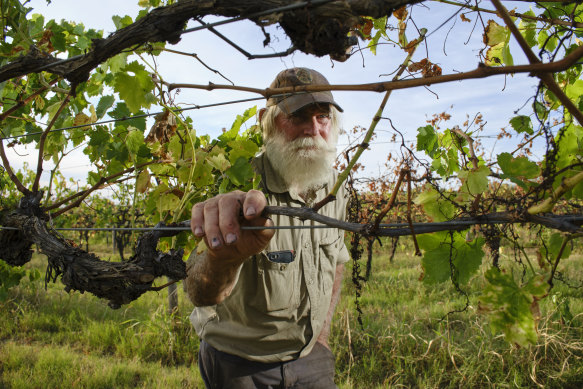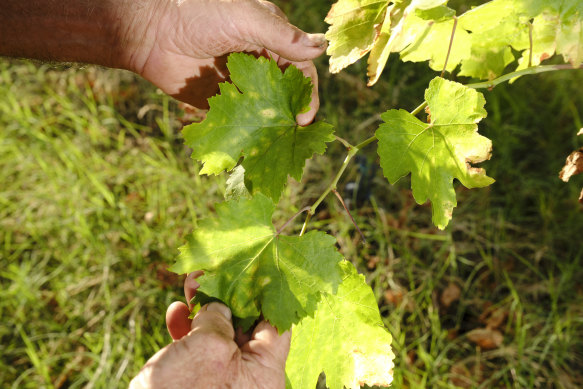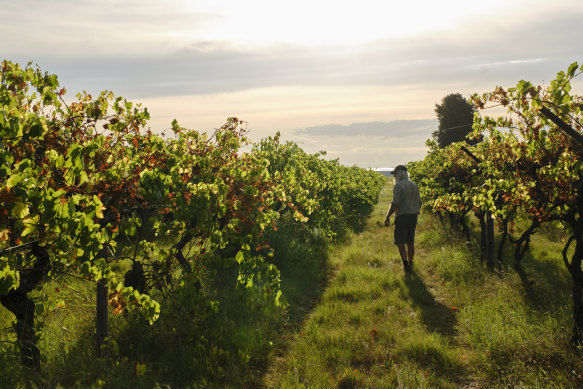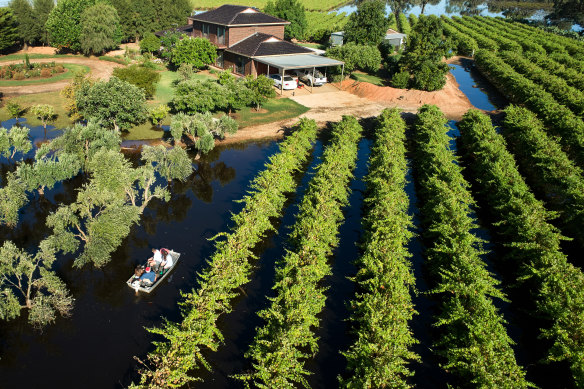Key points
- A crop disease has ravaged many vineyards this year.
- Some growers have lost entire crops after they were unable to spray them.
- Big retailers insist prices will be steady for grapes despite the setback.
When relentless rain saturated Victoria late last year, Andrew Jones knew he was powerless to fight the threat lurking beneath the leaves of his sprawling vineyard in Mildura.
Jones is now one of many growers who have fallen victim to the dreaded downy mildew disease that has already inflicted extensive damage to vineyards in the Murray Valley region.
Andrew Jones inspects his diseased grape vines.Credit:Erin Jonasson
The organic farmer said he would normally be harvesting about 960 kilograms of fruit a week at this time of year, but the disease had all but destroyed his season’s crop.
“This is devastating,” he said. “I’ve never had it like this.”
Downy mildew is among the most feared diseases for grape growers because it causes extensive damage to both table grapes – for eating – and wine grapes.
It thrives in wet conditions when farmers are prevented from getting into their vineyards and spraying their crops to guard them against the disease.
Jones expected to harvest just five tonnes of grapes to be dried for sultanas this season, his worst yield since he began growing the fruit in 1970.
He feared the disease had now laid spores in his vines, which would make it harder to eradicate.
“If the conditions are right next year it might take off again.” Jones said.
Many wine grape growers would tell a similar story.
Murray Valley Winegrowers executive officer Paul Derrico said he knew of growers who had almost lost their entire crops to downy mildew, including some who had taken out large loans anticipating a bumper harvest.
Downy mildew on grapevine leaves. Credit:Erin Jonasson
He said wine grape production had declined by about 100,000 tonnes for the 2023 harvest compared with the five-year average in the Murray Valley region, which equated to about $60 million in losses.
Derrico said growers affected by the disease were now effectively working without pay.
“They’ve gone into debt to produce the crop, and they won’t get a cent back,” he said.
The latest blow to grape growers comes after China, previously the highest value international buyer of Australian wines, imposed heavy tariffs in 2020, which sent exports plummeting.
Andrew Jones inspecting his grape vine amid the browning leaves. Credit:Erin Jonasson
Mildura, one of Victoria’s food bowls, is a major producer of table grapes. However, the region remained flooded well into January, when growers typically begin harvesting.
Dried Fruits Australia chair Mark King was unaware of any growers who had escaped downy mildew altogether, but said some would still produce plentiful crops.
“There are some people who handled it better than others. They were able to get on and spray when they needed to,” he said.
However, King said his own crop in the Pomona region of NSW had been entirely wiped out by the disease.
A farm surrounded by floodwater in Mildura in December. Credit:Ian McKenzie
Victorian Farmers Federation horticulture president Nathan Free said grape yields were well and truly down due to waterlogged vines this year.
“It will mean increased prices on the shelf because there is a lower number of grapes coming onto the market,” he said.
Apples and Sage Organic Wholefoods owner Leo Watling said some grape varieties were now selling for $14.95 a kilogram, compared with $9.95 under more typical circumstances.
He warned prices were unlikely to come down this season at his shop.
“We’ve missed the window,” he said. “There won’t be a greater supply coming through. We’ll have to wait until next year for the next crop.”
Despite the disease outbreak, Coles and Woolworths insisted grapes would be in plentiful supply over the remainder of the season and prices would remain stable.
However, they both conceded that cool weather had delayed the beginning of the grape season.
Australian Grape and Wine chief executive Lee McLean said while downy mildew had hit hard inland growing regions, other grape areas, on the Mornington Peninsula and in the Yarra Valley, had experienced more favourable conditions.
“The vintage is likely to be well down in the Murray Valley and other inland regions due to downy mildew,” he said.
Get to the heart of what’s happening with climate change and the environment. Our fortnightly Environment newsletter brings you the news, the issues and the solutions. Sign up here.
Most Viewed in National
From our partners
Source: Read Full Article




